For many dog lovers, the idea of sharing their home with a canine companion is a dream come true. However, the reality of dog allergies and the constant battle against shedding can quickly dampen the joy. Beyond allergens, the time and cost associated with frequent professional grooming can also be a significant consideration for potential pet parents. This is where the allure of “hypoallergenic” dogs, and more specifically, dogs that truly don’t shed much and require minimal grooming, comes into play.
While the term “hypoallergenic” is often used to describe dogs that produce fewer allergens, it’s crucial to understand that no dog is 100% allergen-free. Even low-shedding breeds can carry allergens in their dander (flakes of skin), saliva, and urine. The real game-changer for many is finding a breed that combines low shedding with easy-to-manage grooming needs. This means less fur around the house, potentially fewer allergic reactions, and a more streamlined pet care routine. If you’re seeking a furry friend that offers companionship without demanding excessive hair cleanup or professional salon visits, you’ve come to the right place. We’ll explore breeds that fit this description, balancing their low-shedding qualities with practical, minimal grooming requirements to help you find your perfect, low-maintenance canine companion.
Understanding “Low Shedding” and “Minimal Grooming”
Before diving into specific breeds, it’s important to clarify what “low shedding” and “minimal grooming” truly mean in the context of dog ownership. These terms are often misunderstood, leading to unrealistic expectations.
The Reality of “Low Shedding”
“Low shedding” typically refers to dog breeds that shed significantly less hair than average. This doesn’t mean they don’t shed at all, but rather that their hair growth cycle often differs, resulting in less loose hair being released into the environment. Many dogs labeled “hypoallergenic” fall into this category because the dander (skin flakes) that often triggers allergies tends to cling to the hair, and less shedding means less dander dispersed. However, less shedding usually translates to a coat that continues to grow and may require trimming or specific care to prevent matting. For those looking for best indoor dog breeds that don’t shed, these low-shedding qualities are a primary draw.
Defining “Minimal Grooming”
“Minimal grooming” is perhaps the most debated aspect. It rarely means “zero grooming.” All dogs require some basic care, including nail trims, ear cleaning, and occasional baths. For this article, “minimal grooming” refers to breeds whose coats are:
- Easy to maintain at home: Requiring only basic brushing a few times a week, simple baths, and no complex styling or stripping.
- Less prone to matting: Even if they have longer hair, it’s typically a texture that doesn’t knot easily.
- Do not necessarily require professional grooming: While a professional groomer can always be beneficial, it’s not a necessity for the breed’s coat health and appearance. This often excludes breeds with continuously growing, dense curly coats that need regular clipping (like many Poodles and Doodles).
Therefore, when we look for “dogs that don’t shed and don’t need grooming,” we are seeking breeds that combine very low shedding with straightforward, easily manageable at-home coat care.
Top Dog Breeds That Don’t Shed and Require Minimal Grooming
Finding a dog that perfectly fits both “non-shedding” and “zero grooming” can be challenging, as many low-shedding breeds (like Poodles) have coats that grow continuously and require regular clipping. However, some breeds come very close to the ideal of minimal maintenance. Here, we highlight breeds known for their very low shedding and manageable grooming needs.
Truly Minimal Grooming: Hairless & Short-Coated Wonders
These breeds often top the list for true low-maintenance coat care, largely due to their unique hairless or very short, smooth coats.
1. Chinese Crested
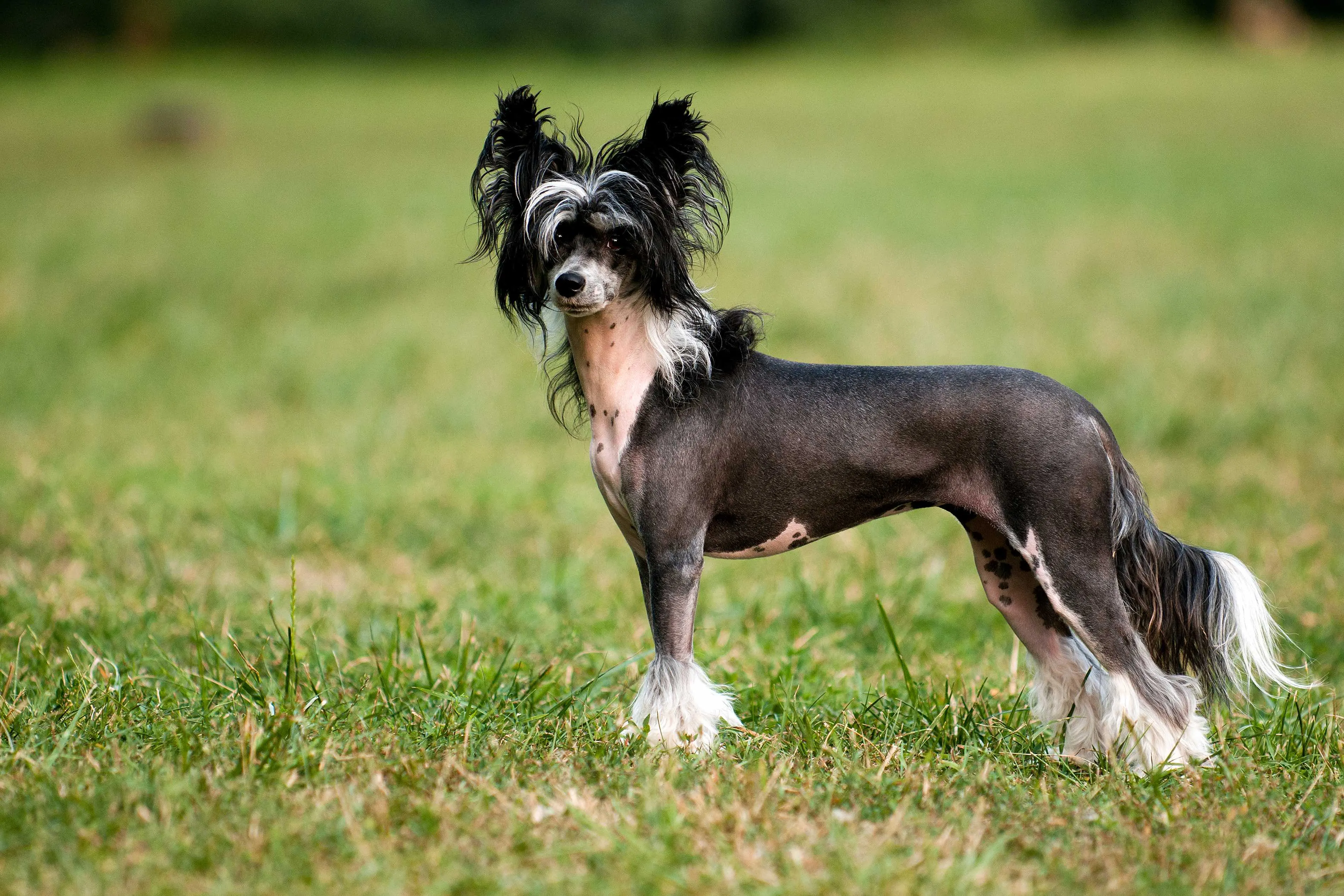 Hairless Chinese Crested dog looking at the camera
Hairless Chinese Crested dog looking at the camera
The Chinese Crested is renowned for its distinctive appearance and comes in two varieties: hairless and powderpuff. The hairless variety is a prime candidate for minimal grooming, possessing smooth, soft skin with tufts of hair only on their head, tail, and paws. This means no shedding and very little coat care; instead, their skin requires attention similar to human skin, including moisturizing and sun protection. The powderpuff version has a full, silky coat that requires more regular brushing to prevent tangles, but still sheds minimally. Both varieties are playful, affectionate, and make wonderful companions, adapting well to various living situations.
2. Xoloitzcuintli (Mexican Hairless Dog)
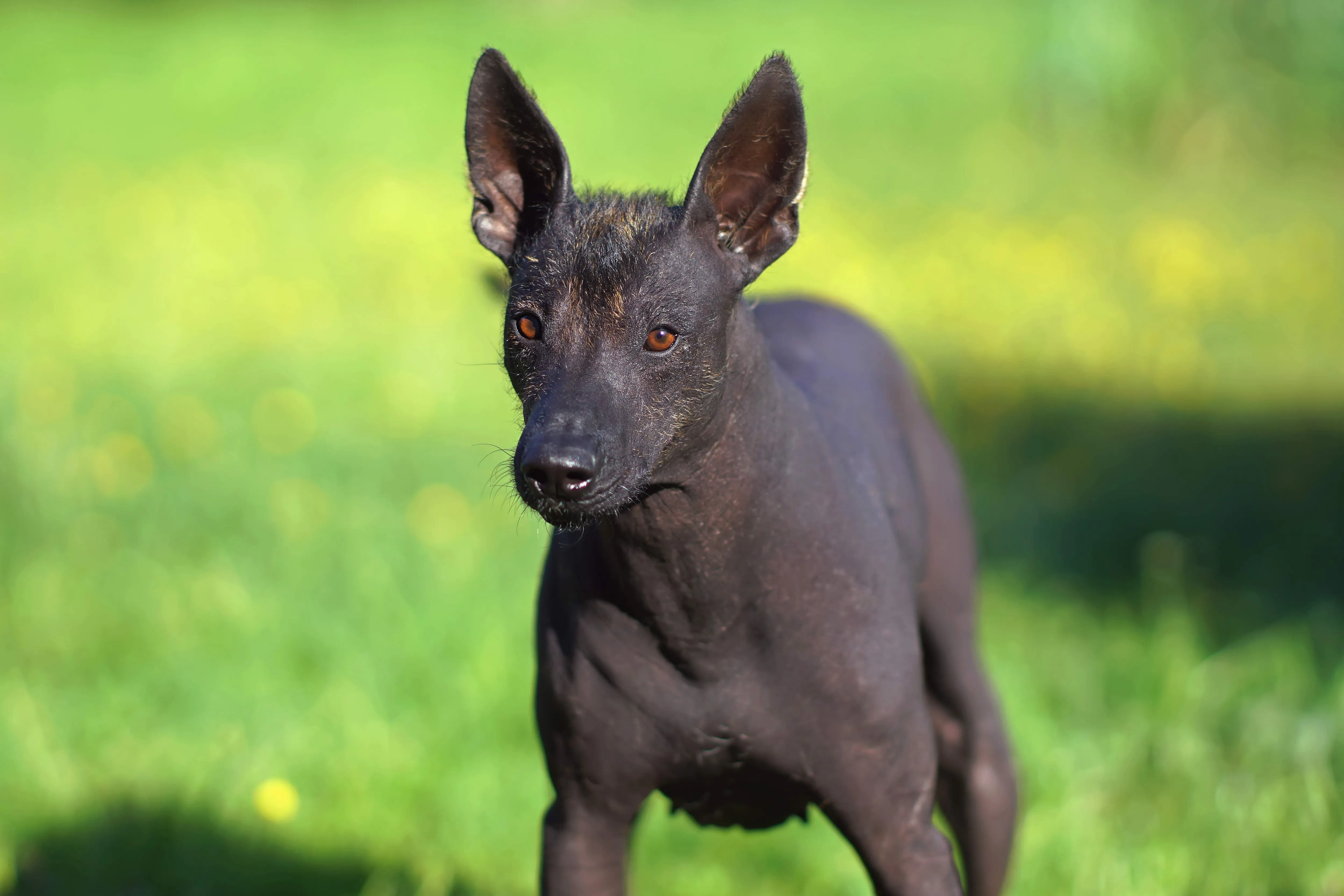 Black Mexican Hairless Dog standing in grass
Black Mexican Hairless Dog standing in grass
The Xoloitzcuintli, often simply called Xolo, is one of the oldest and rarest dog breeds, originating from Mexico. Like the Chinese Crested, Xolos come in hairless and coated varieties, both considered low-shedding. The hairless Xolo is an excellent choice for minimal grooming, requiring primarily skin care to keep it moisturized and protected from the elements. The coated variety has a short, smooth coat that sheds very little and needs only occasional brushing. These intelligent and calm dogs come in three sizes (toy, miniature, and standard) and are known for their loyalty and gentle nature with their families. They are also among the calmest dog breeds that don’t shed, making them ideal for serene homes.
3. Peruvian Inca Orchid
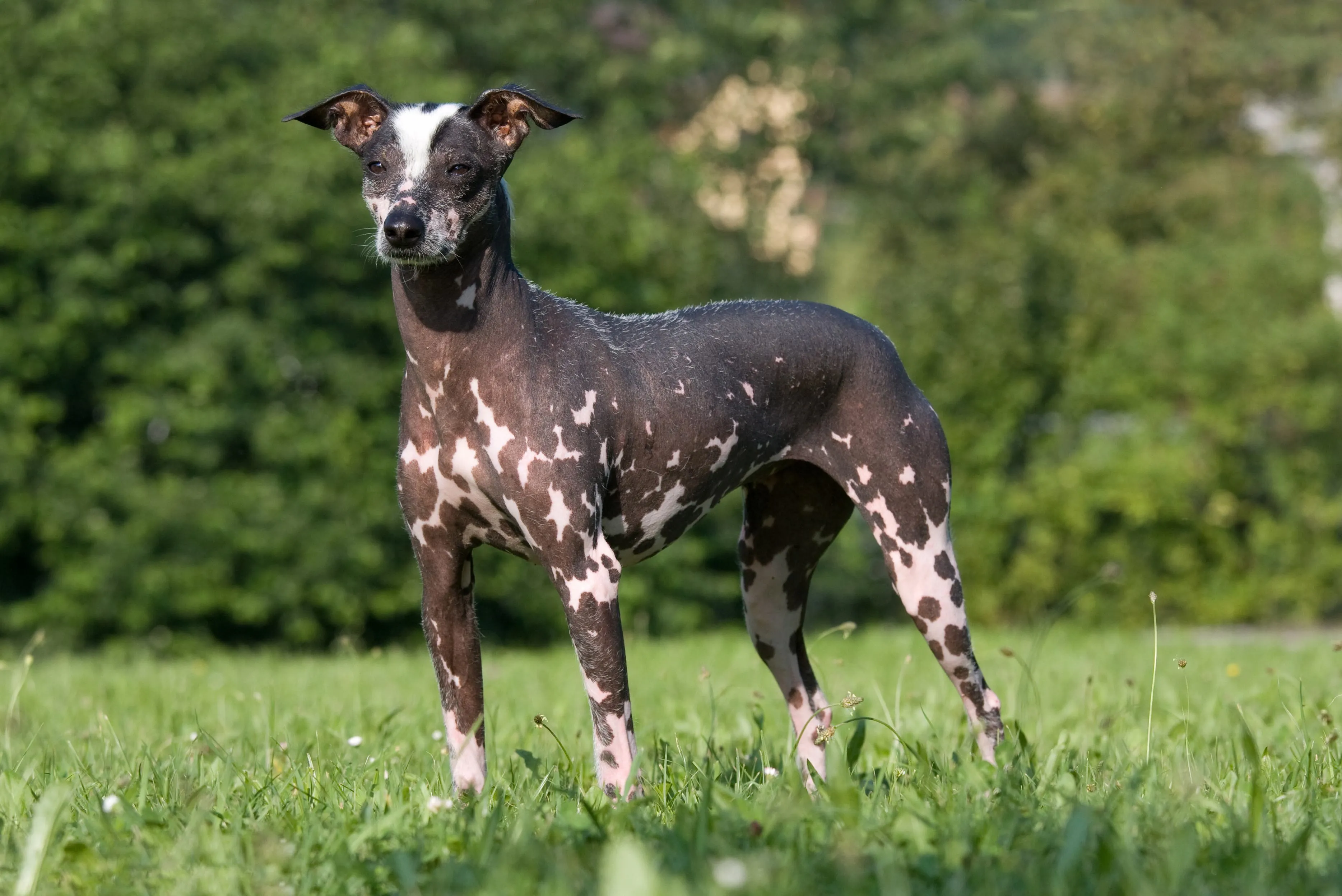 Peruvian Inca Orchid dog
Peruvian Inca Orchid dog
Similar to the Xolo, the Peruvian Inca Orchid is an ancient and relatively rare hairless breed from Peru, revered for its elegant appearance and unique characteristics. They come in small, medium, and large sizes. Their nearly hairless bodies mean virtually no shedding and minimal coat grooming. Owners should focus on skin care, protecting them from sunburn and cold weather. These dogs are alert, affectionate with their families, and can be reserved with strangers, making them excellent watchdogs. Their calm demeanor combined with their minimal grooming makes them a hidden gem for those seeking a truly low-maintenance companion.
Easy At-Home Grooming: Smooth & Wiry Coats
These breeds may have more hair than the hairless varieties, but their coat types are typically easy to manage with basic at-home care, without requiring intricate styling or frequent professional cuts.
4. Affenpinscher
 Black Affenpinscher dog close-up
Black Affenpinscher dog close-up
Affenpinschers are small, charming dogs known for their distinctive “monkey-like” faces. Their dense, wiry coat sheds very little, making them a good option for those concerned about allergies. While their coat does require care, it’s often more manageable than a poodle’s curl. It needs regular brushing to prevent tangles and remove loose hair, and occasional hand-stripping (a process of removing dead hair by the root, which can be done at home or by a professional) to maintain its texture. This isn’t “no grooming,” but it’s less about shedding and more about maintaining the coat’s wiry texture. They are curious, mischievous, and affectionate companions.
5. Bedlington Terrier
 White Bedlington Terrier running through snow
White Bedlington Terrier running through snow
Often described as “a lamb in dog’s clothing,” the Bedlington Terrier is a small, unique breed with a curly, woolly coat that is low-shedding. While their coat continuously grows and needs regular trimming to maintain its distinctive appearance (including their signature topknot and pom-pom ear tufts), it’s generally not prone to heavy shedding. Owners can learn to trim their Bedlington at home, making it a manageable grooming task, though some may opt for professional help to achieve the precise look. These dogs are known for their playful and affectionate nature and can develop strong bonds with their families, though they can be prone to separation anxiety if left alone for extended periods.
Manageable Grooming: Low-Shedding Curly & Silky Coats
These breeds are excellent for their low-shedding qualities but do require regular brushing and often professional clipping or dedicated at-home trimming to keep their coats healthy and mat-free. While not “no grooming,” their maintenance is primarily focused on coat health rather than managing shed hair.
6. Poodle (Standard, Miniature, and Toy)
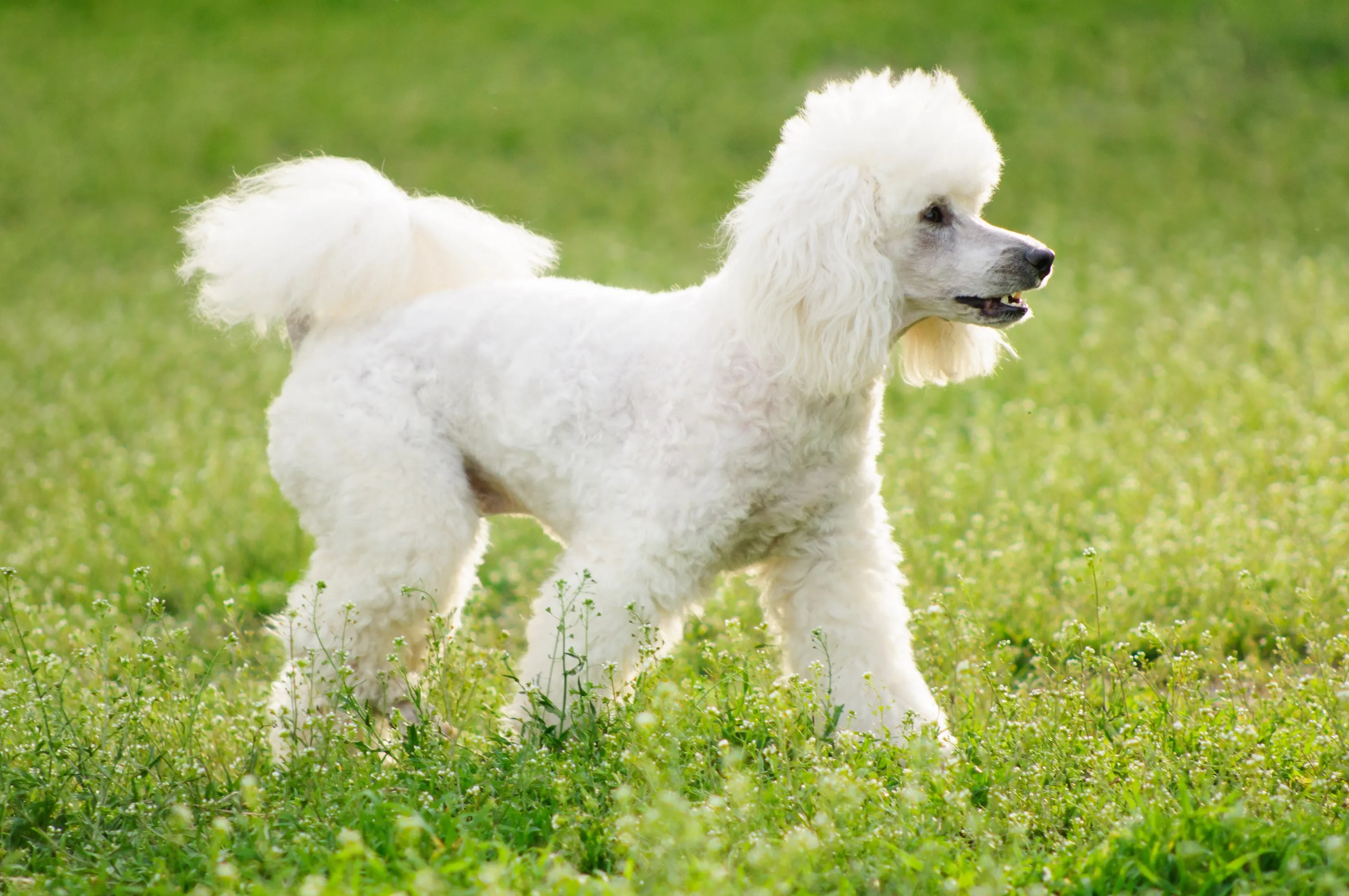 White Poodle walking through grass
White Poodle walking through grass
Poodles are perhaps the most well-known low-shedding breed, celebrated for their intelligence and elegant appearance. All three sizes – Standard, Miniature, and Toy – shed minimally, making them a top choice for allergy sufferers. However, their curly, dense coats grow continuously and are highly prone to matting if not regularly brushed and professionally clipped every 4-6 weeks. While they don’t shed much, they certainly need grooming. Owners can learn to do some basic grooming at home, but professional trims are often essential to maintain their coat’s health and appearance. Poodles are highly trainable, active, and make wonderful family pets.
7. Yorkshire Terrier
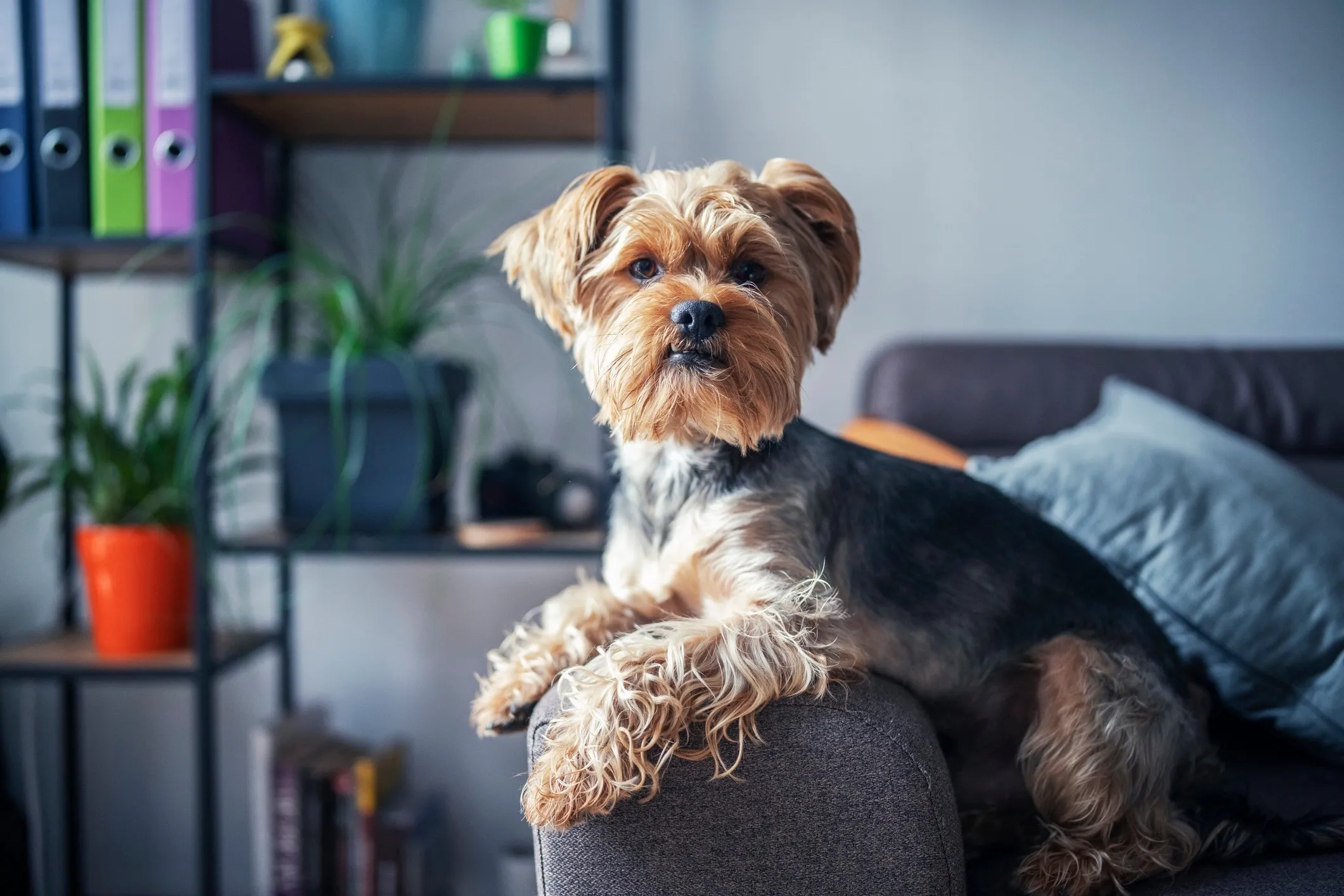 Blue and tan Yorkie lounging on an armchair
Blue and tan Yorkie lounging on an armchair
Little Yorkies are charming, spunky dogs with a long, silky coat that is more similar to human hair than typical dog fur. This means they shed very little. However, their luxurious coats require daily brushing to prevent tangles and mats. Many Yorkie owners opt for a shorter “puppy cut” to simplify grooming, but even then, regular brushing is necessary. So, while they don’t shed, they absolutely need consistent grooming. Yorkies adapt well to various living situations and are known for their affectionate personalities, thriving on attention from their families.
8. Shih Tzu
 Brown and white Shih Tzu lying on a living room floor
Brown and white Shih Tzu lying on a living room floor
The Shih Tzu, an ancient companion breed, boasts a thick, flowing double coat that sheds minimally. Like the Yorkie, this coat requires significant daily brushing to prevent severe matting, especially if kept long. Many owners choose to keep their Shih Tzu in a shorter “puppy cut” to make grooming more manageable, but even with short hair, regular brushing is key. Their friendly temperament makes them excellent family pets, though their flat faces can predispose them to certain health issues like overheating and breathing problems. Despite being low-shedding, they are a breed with high grooming demands.
9. Miniature Schnauzer
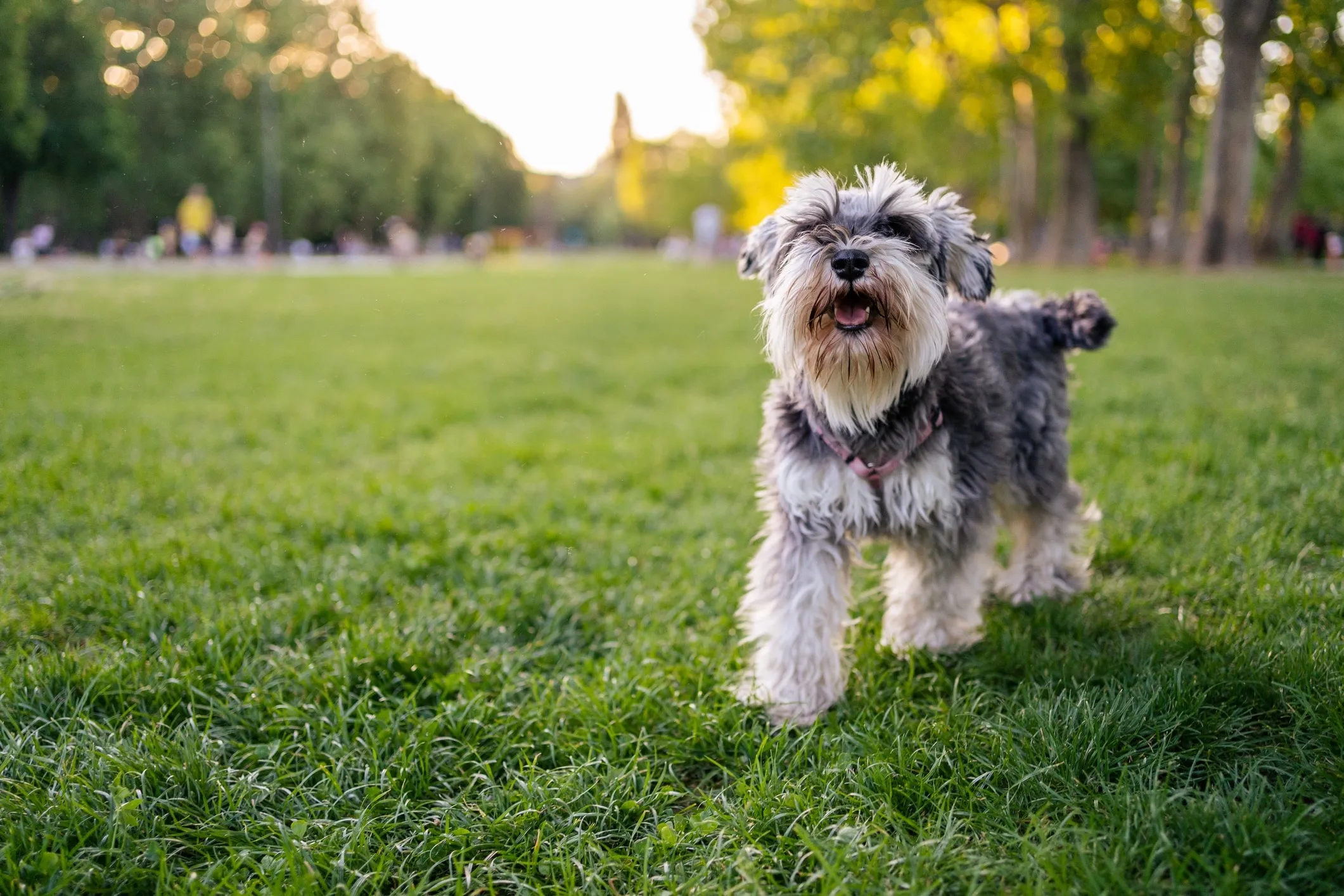 Salt and pepper Miniature Schnauzer wearing a pink harness in a park
Salt and pepper Miniature Schnauzer wearing a pink harness in a park
Miniature Schnauzers have a distinctive wiry outer coat and a soft undercoat that sheds very little. This breed requires regular grooming, including brushing a few times a week and either hand-stripping or clipping every 5-8 weeks to maintain their coat’s texture and shape. While this is certainly more than “minimal grooming,” their low-shedding quality makes them a popular choice for those with allergies. These smart, spirited dogs are adaptable and fit well into many different living environments, provided they get sufficient exercise.
10. Standard Schnauzer
 Gray Standard Schnauzer standing in a field
Gray Standard Schnauzer standing in a field
The Standard Schnauzer shares the low-shedding wiry coat characteristics of its miniature counterpart but in a larger package. They require similar grooming: regular brushing and professional stripping or clipping to keep their coat healthy and tidy. Despite the grooming needs, their minimal shedding is a significant advantage. Standard Schnauzers are intelligent, loyal, and energetic dogs who love activities like long walks, playing fetch, and solving puzzle toys. They can be considered smart family dogs that don’t shed.
11. Giant Schnauzer
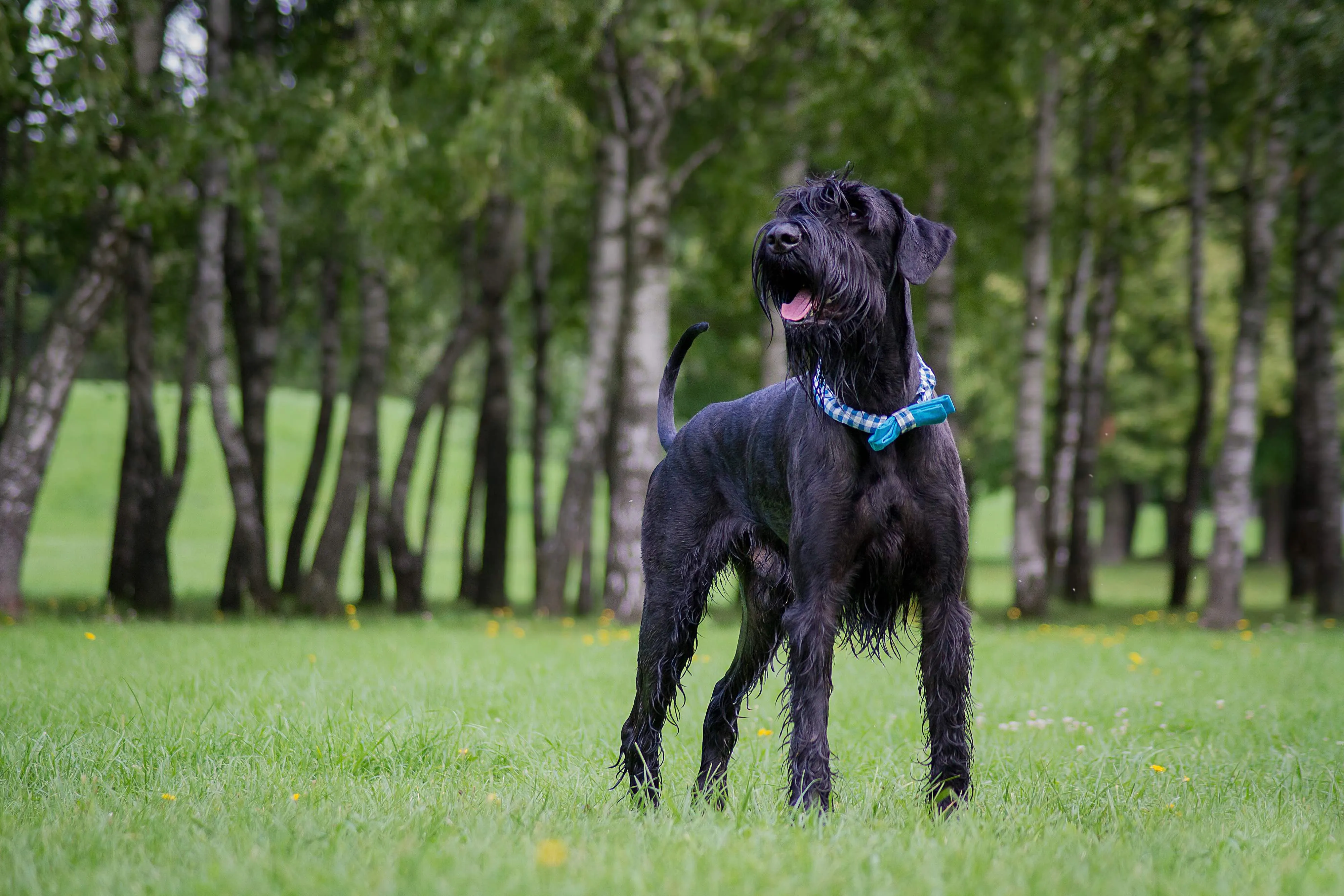 Black wet Giant Schnauzer wearing a blue bow collar standing in a park
Black wet Giant Schnauzer wearing a blue bow collar standing in a park
Giant Schnauzers, the largest of the Schnauzer breeds, also possess a dense, wiry coat that sheds very little. Their grooming demands mirror the smaller Schnauzers, involving regular brushing and either hand-stripping or clipping to prevent matting and maintain coat health. These powerful, intelligent, and protective dogs need substantial exercise and mental stimulation to thrive. While they are low-shedding, their grooming is a commitment, making them a less-than-perfect fit for the “no grooming” criteria, but excellent for “non-shedding.” They are also one of the large calm dog breeds that don’t shed.
12. Bichon Frise
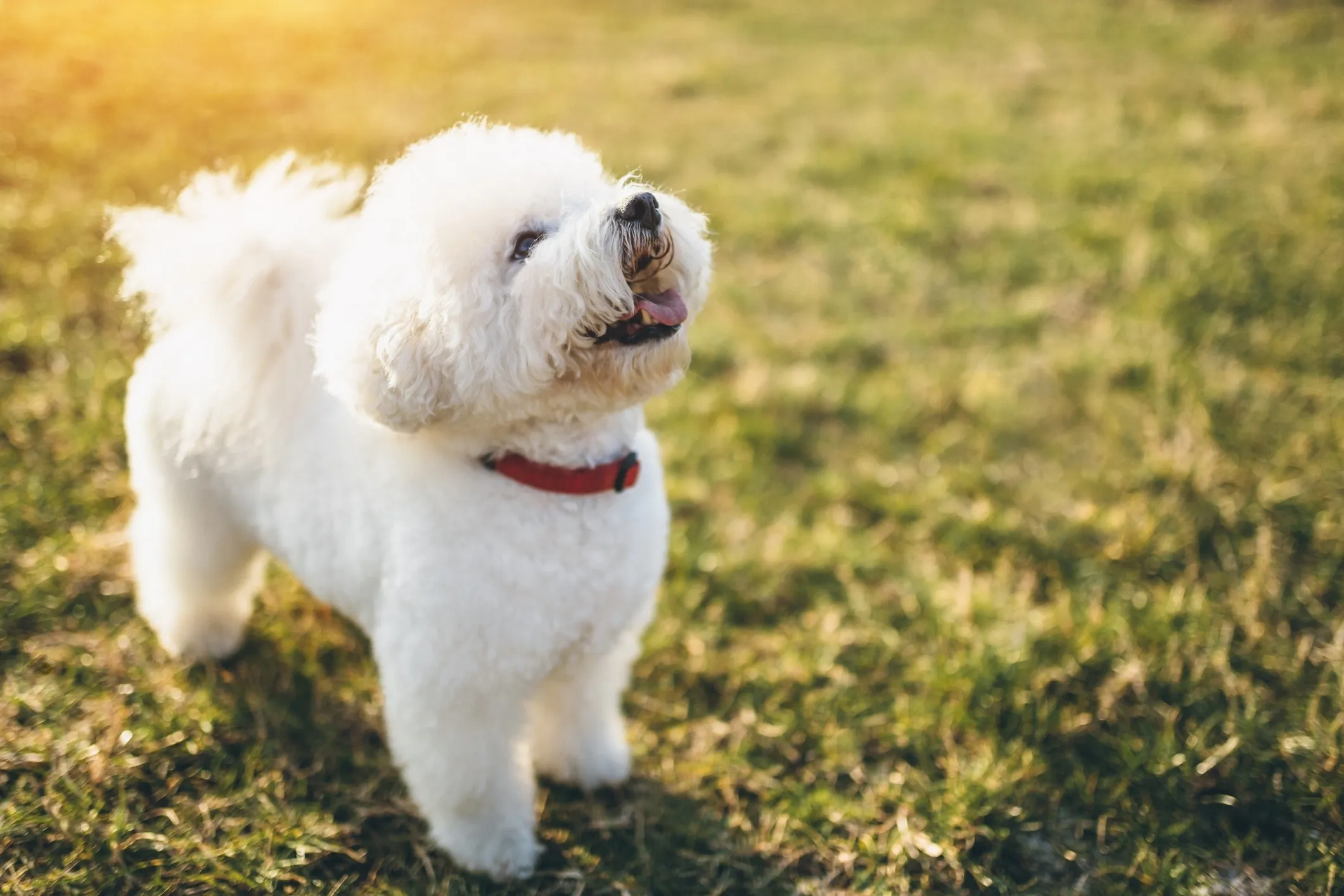 White Bichon Frise dog looking up in the grass
White Bichon Frise dog looking up in the grass
Small, playful, and affectionate, the Bichon Frise has a soft, curly double coat that sheds minimally, with loose hair typically caught within the curls. To prevent severe matting, their coat requires daily brushing and professional grooming (clipping) every 4-6 weeks. While their non-shedding quality is a huge plus, their grooming needs are significant. Bichons are highly intelligent and trainable, quickly mastering basics with positive reinforcement, and are known for their cheerful disposition.
13. Portuguese Water Dog
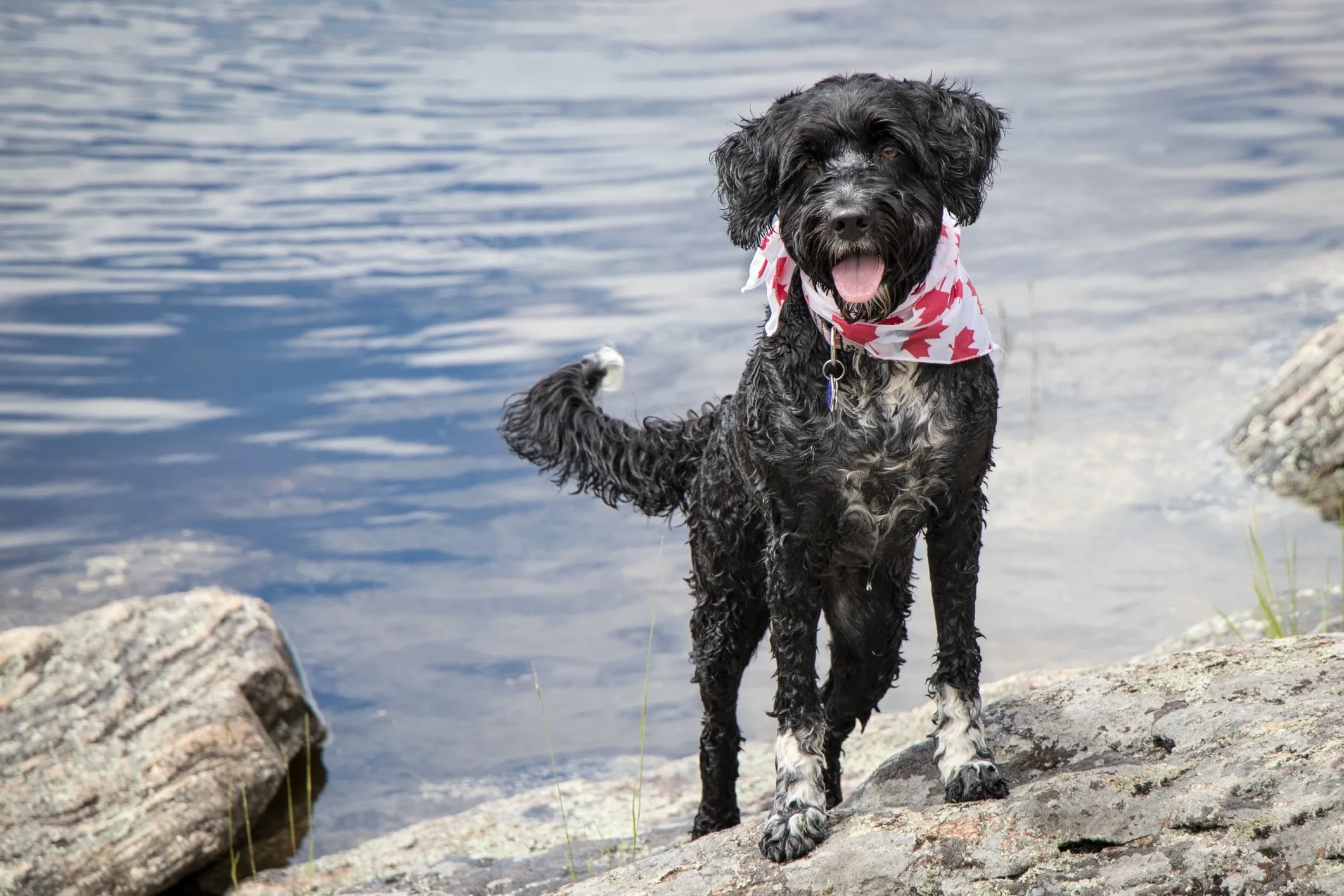 Black and white Portuguese Water Dog wearing a red maple leaf bandana in front of water
Black and white Portuguese Water Dog wearing a red maple leaf bandana in front of water
Originally bred as an aid to fishermen, Portuguese Water Dogs possess a thick, curly coat that sheds very little, making them a popular choice among allergy sufferers. However, their continuously growing coat requires regular brushing (several times a week) and professional clipping every 6-8 weeks to prevent matting and maintain hygiene. They are intelligent, highly trainable, and friendly, with a high energy level that needs regular exercise, especially swimming, which they adore. So, while low-shedding, they are high-grooming.
14. Lagotto Romagnolo
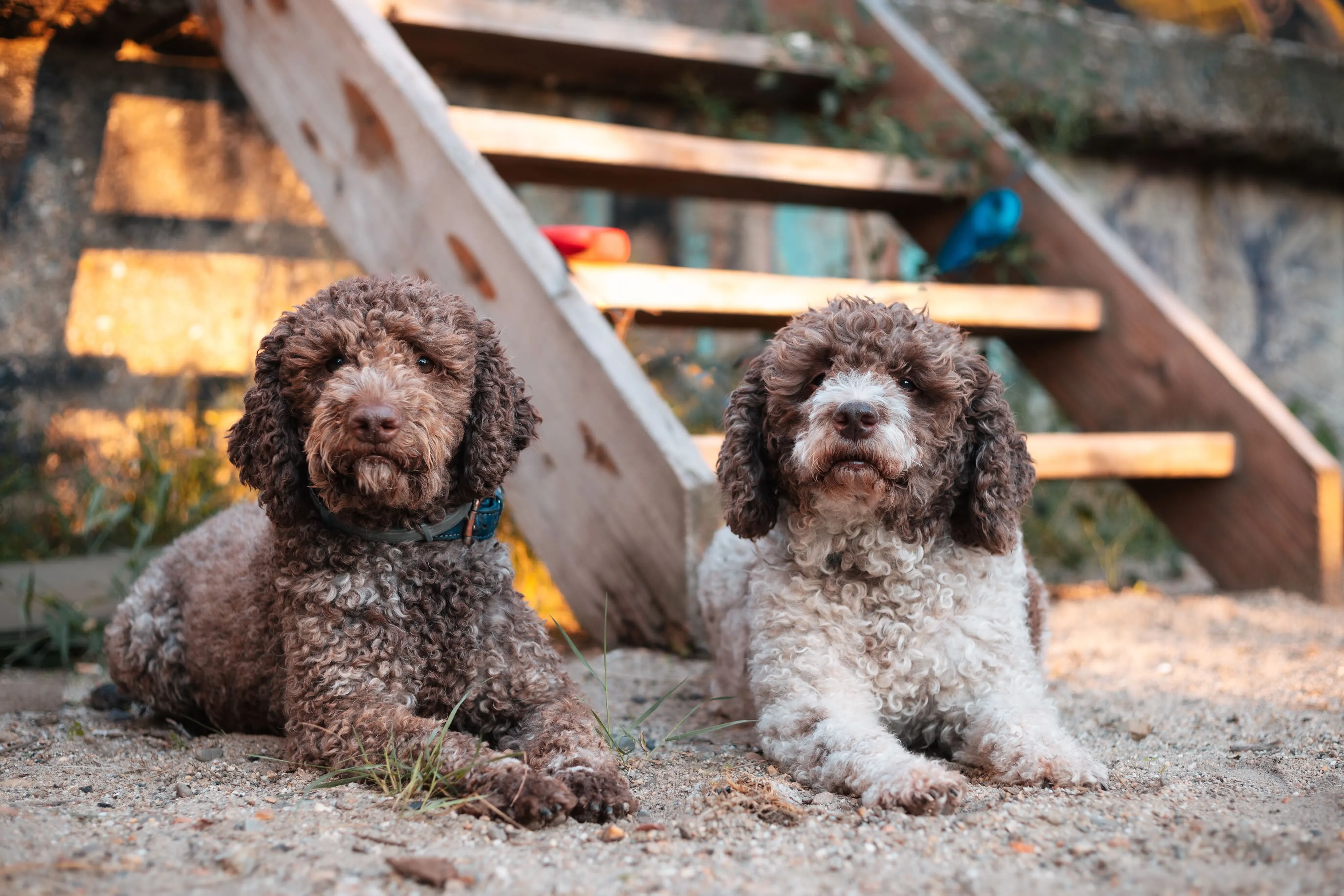 Two Lagotto Romagnolo dogs lying in dirt staring at the camera
Two Lagotto Romagnolo dogs lying in dirt staring at the camera
Lagotto Romagnolo dogs were originally water retrievers, and their curly, woolly coat protected them from cold waters. This coat is low-shedding but needs regular brushing and trimming to prevent matting, especially when wet. They are less common but are known to be good with children and other pets, making them excellent family dogs. Their grooming is manageable for a dedicated owner, but it’s far from “no grooming.”
15. Irish Water Spaniel
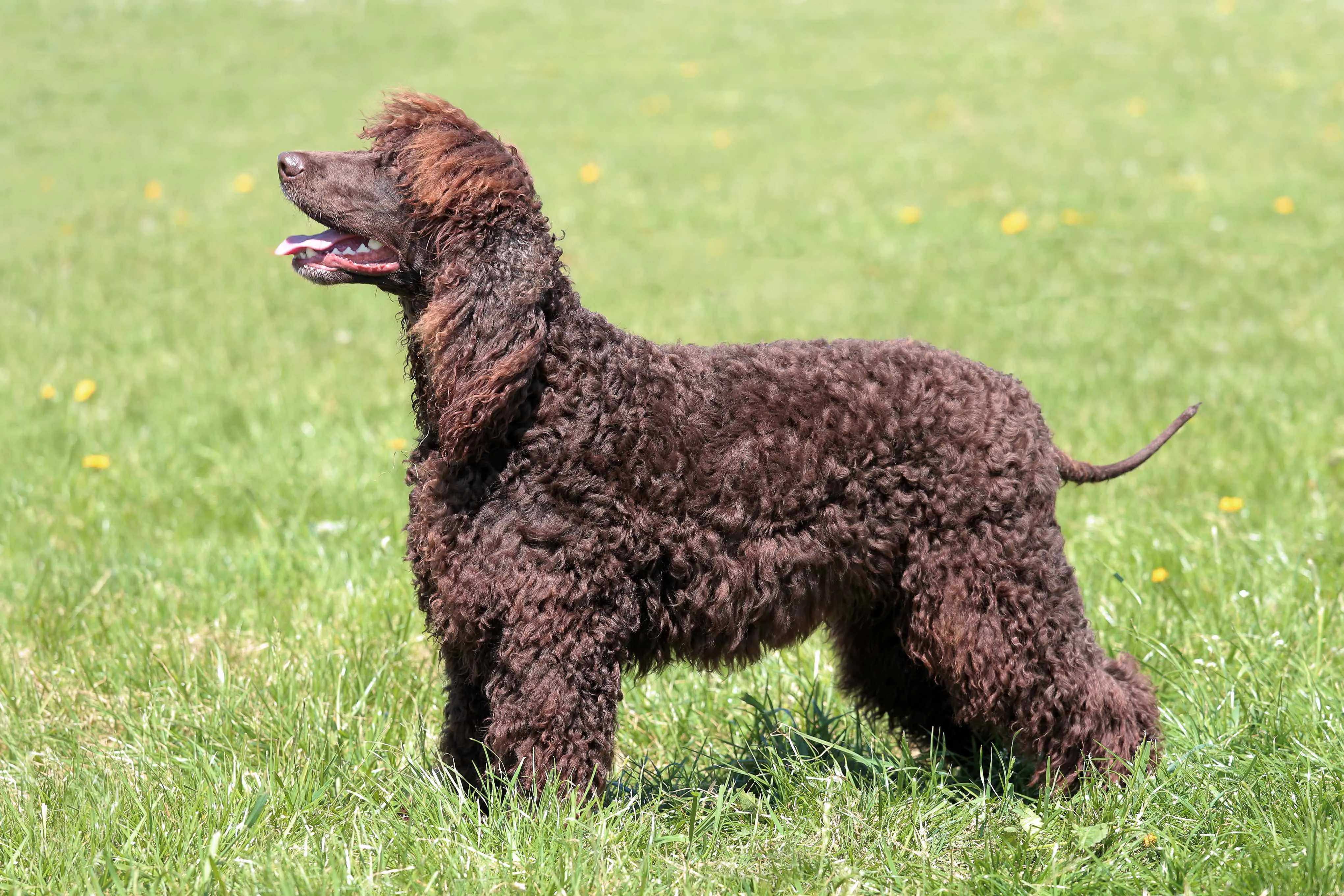 Brown Irish Water Spaniel profile
Brown Irish Water Spaniel profile
Friendly, intelligent, and highly trainable, Irish Water Spaniels are another water dog breed with a thick, curly coat that sheds minimally. Like other curly-coated breeds, it requires regular brushing and occasional professional grooming to keep it healthy and free of mats. Their coat is always a rich liver (brown) color. These dogs have high energy levels and require significant exercise to stay happy and healthy.
16. Bolognese
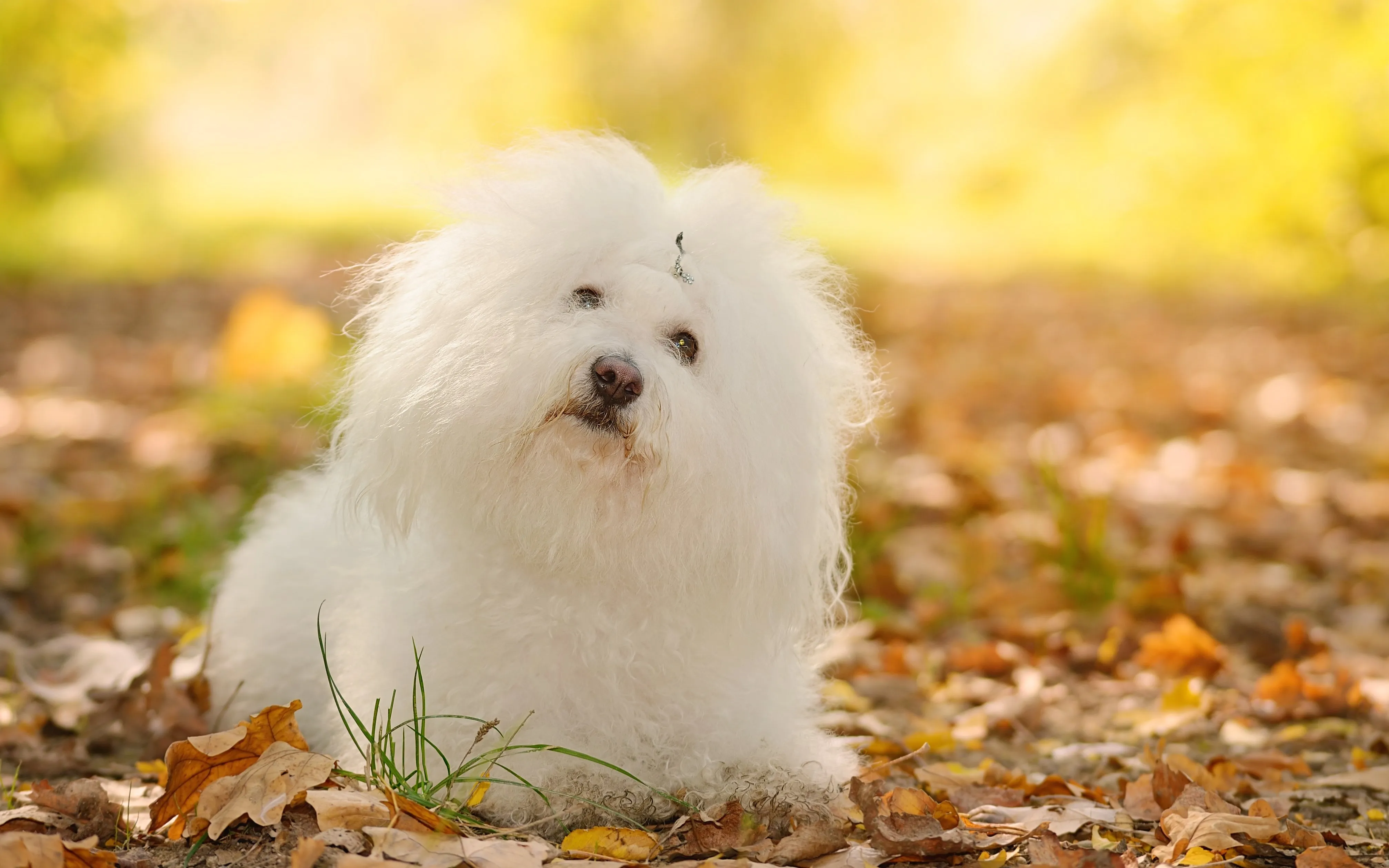 White Bolognese dog sitting in an autumn forest
White Bolognese dog sitting in an autumn forest
Bolognese are cute, small dogs with a long, fluffy white coat that sheds minimally. Despite its characteristic messy appearance, this coat needs regular brushing to prevent matting. They are playful, easygoing pups known for getting along well with children and other pets, and they can adapt to various living situations. Their grooming is a daily commitment to brushing.
17. Maltese
 Woman holding a white Maltese dog on a bed
Woman holding a white Maltese dog on a bed
The Maltese is a small, elegant dog known for its luxurious, long, silky white coat that sheds very little. However, this beautiful coat requires daily brushing to prevent tangles and mats. Many owners opt for a shorter “puppy cut” to reduce grooming time, but even then, consistent brushing is essential. Maltese make affectionate and playful companions for pet parents dedicated to their grooming needs. Their minimal shedding is a bonus, but their grooming is demanding.
18. Soft Coated Wheaten Terrier
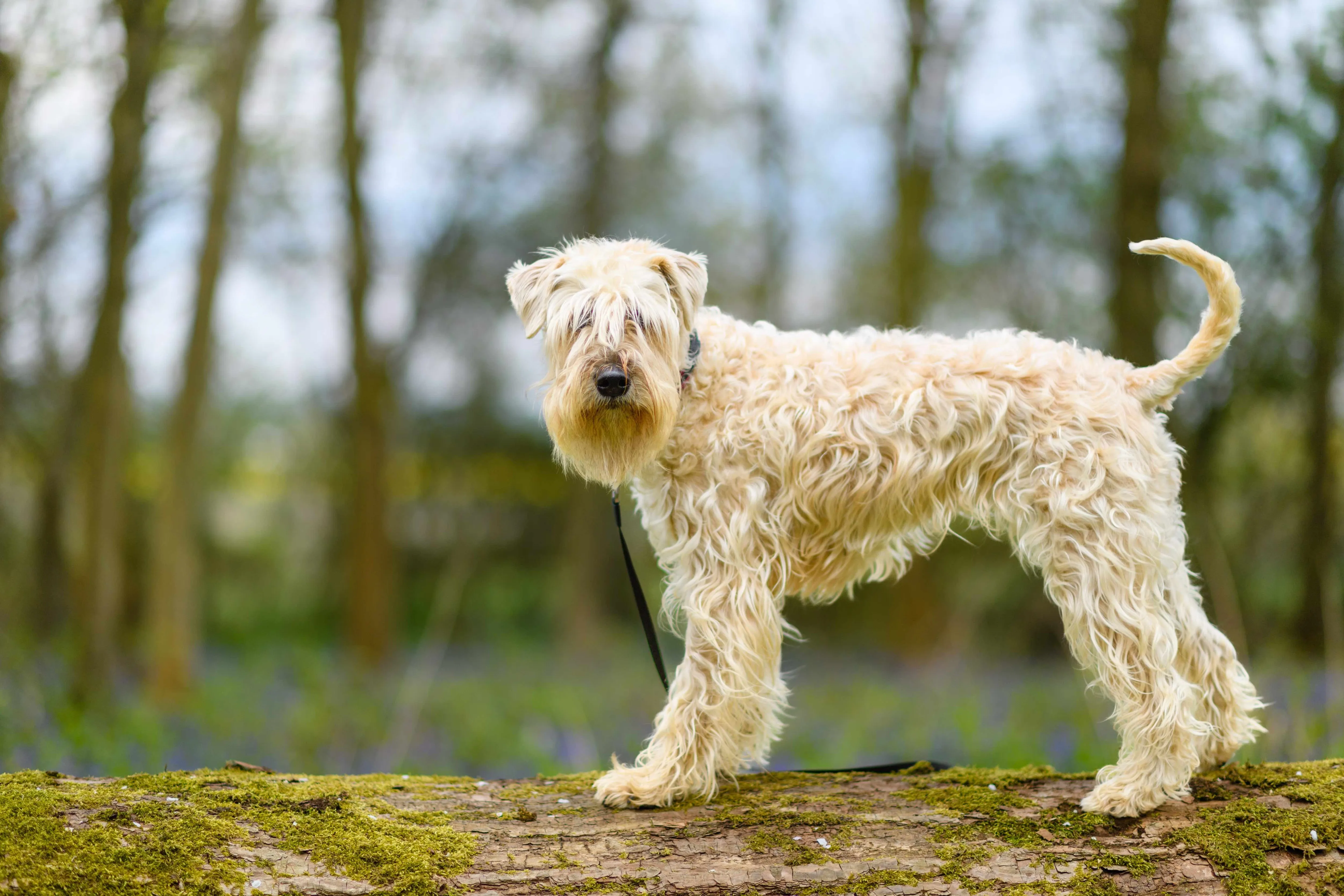 Soft Coated Wheaten Terrier dog on a log
Soft Coated Wheaten Terrier dog on a log
The Soft Coated Wheaten Terrier is a medium-sized Irish breed famous for its silky, soft coat that sheds minimally. While incredibly soft to the touch, this coat needs regular brushing (several times a week) to prevent matting. It also requires occasional trimming to maintain its shape and health. Wheatens are high-energy terriers that need ample exercise and mental stimulation to be well-behaved and happy companions.
19. Coton de Tulear
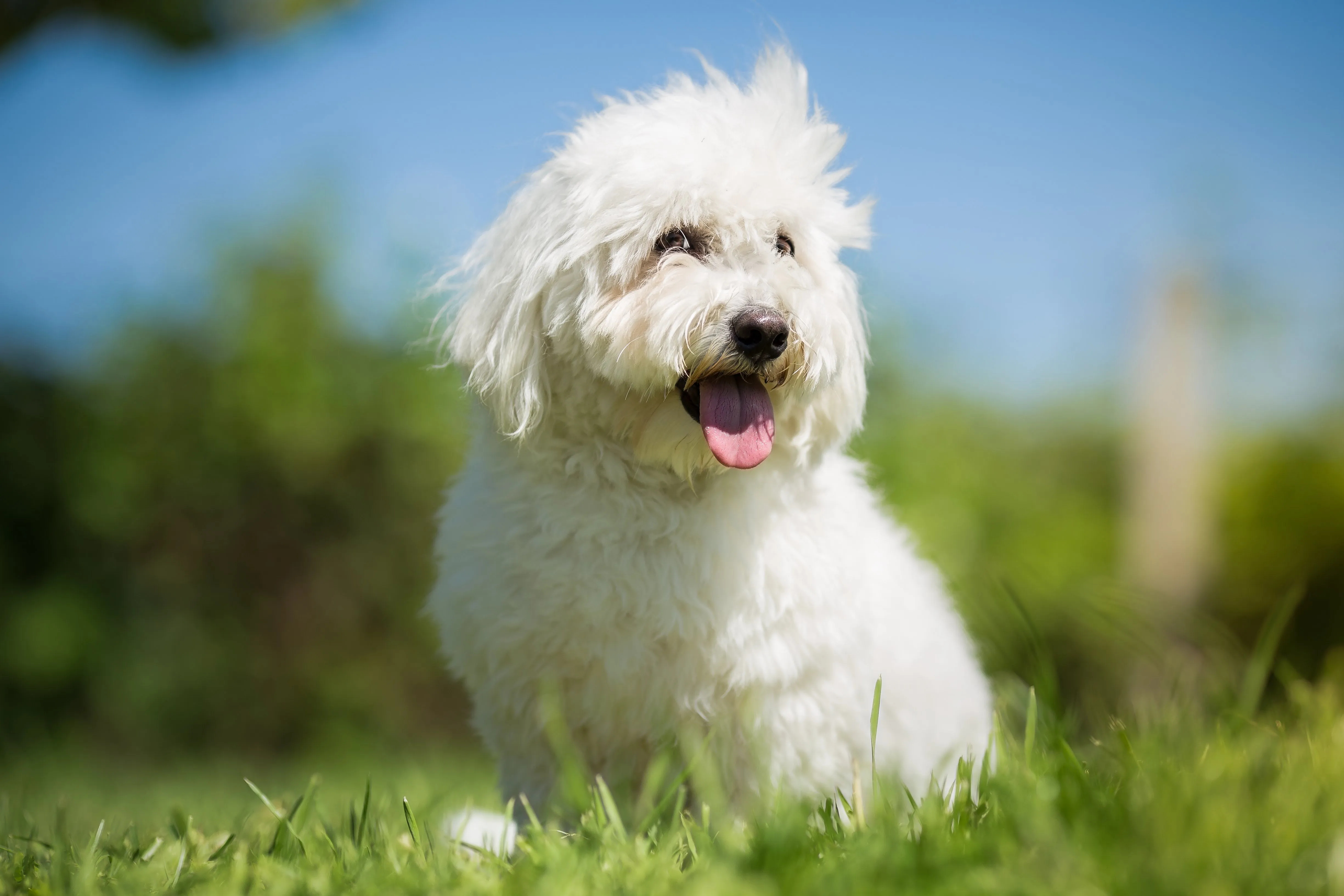 White Coton de Tulear sitting in grass with hair blowing in the wind
White Coton de Tulear sitting in grass with hair blowing in the wind
A small, charming breed from Madagascar, Cotons de Tulear have a soft, cotton-like coat that sheds minimally. This beautiful coat, however, needs regular brushing to prevent tangles and mats. Cotons are known for their easygoing and good-natured temperament, making them a good fit for families with children and other pets, especially with proper introductions.
20. Afghan Hound
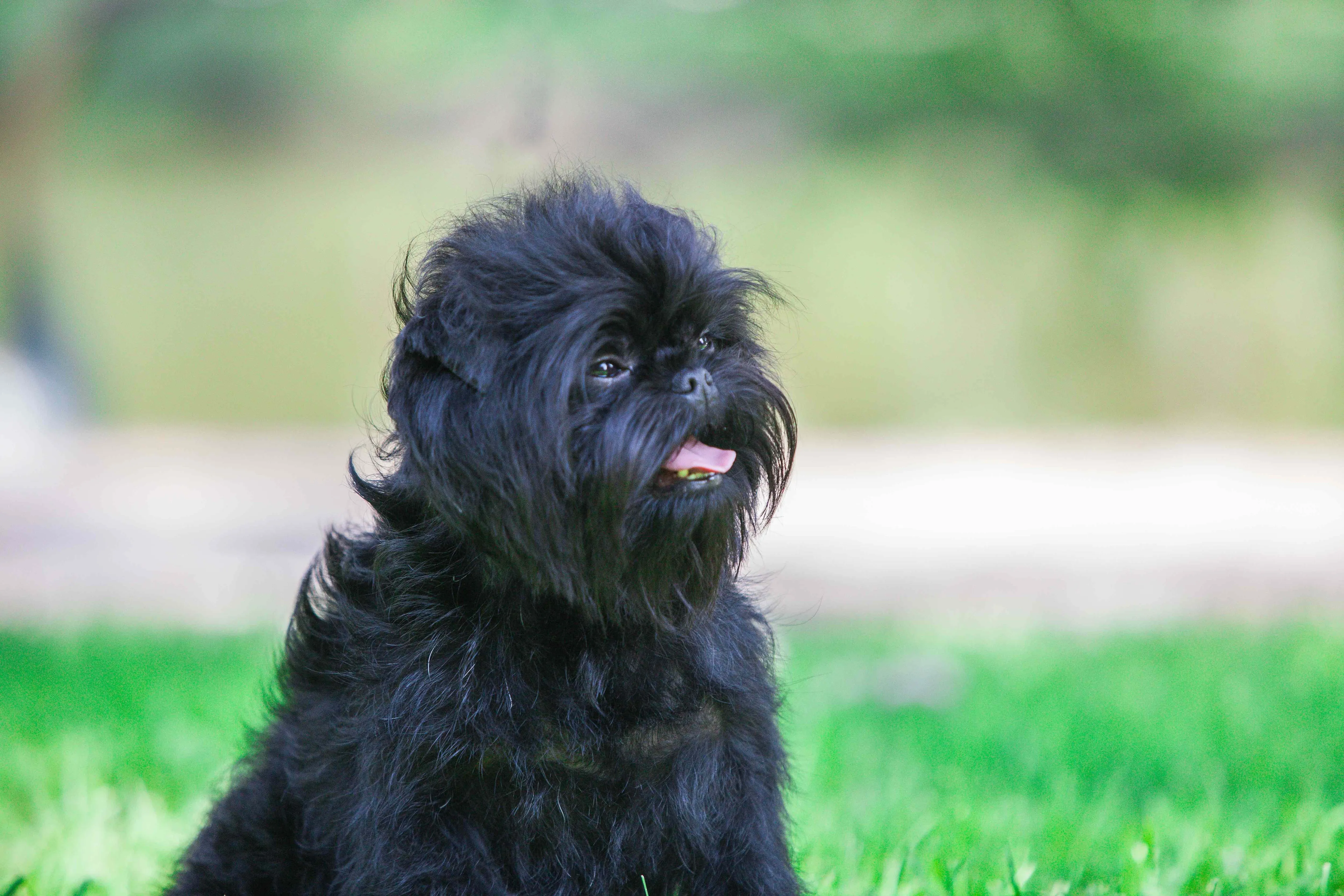 Gray and tan Afghan Hound looking at the camera
Gray and tan Afghan Hound looking at the camera
Afghan Hounds are striking dogs, famed for their long, flowing, silky coats and slender builds. While they are considered low-shedding compared to many breeds, their extensive coat demands an immense amount of grooming. Daily, thorough brushing is absolutely essential to prevent matting, and many owners opt for professional grooming to manage their magnificent locks. They are loving towards their family but can be aloof with strangers, requiring early and consistent socialization. Due to their extreme grooming needs, they do not fit the “minimal grooming” criterion.
21. Barbet
 Close-up of a curly red Barbet dog face
Close-up of a curly red Barbet dog face
The Barbet, pronounced “bar-bay,” is a cheerful dog with a shaggy, woolly coat that sheds minimally. True to its French name, meaning “beard,” they often have a characteristic hairy chin. Their protective curly coat makes them love to swim. To keep their coat in good condition, especially after swimming, they require brushing two to three times a week and occasional trimming to prevent matting.
Doodle Breeds: Low-Shedding with Varied Grooming Needs
Doodle breeds are often sought after for their low-shedding Poodle lineage, but their grooming requirements can vary significantly depending on the coat type inherited. Most still require regular brushing and professional trimming.
22. Labradoodle
 Brown Standard Labradoodle walking in a park
Brown Standard Labradoodle walking in a park
A crossbreed between a Labrador Retriever and a Poodle, Labradoodles were originally bred to be hypoallergenic service dogs. Their coats can vary from wavy to curly, with most shedding minimally. However, to prevent matting, they require regular brushing (several times a week) and professional grooming (clipping) every 6-8 weeks. They are intelligent, friendly, and make excellent family pets, known for their trainability and gentle nature when well-exercised and socialized.
23. Goldendoodle
 Goldendoodle lying on a couch with a person sitting in the background
Goldendoodle lying on a couch with a person sitting in the background
Goldendoodles are another popular “doodle dog,” a cross between a Golden Retriever and a Poodle. Like Labradoodles, they are cherished for their low-shedding coats, friendly nature, and high intelligence. Their coats also range from wavy to curly and require frequent brushing with a slicker brush and regular professional grooming to prevent matting. While their golden coat is iconic, they can come in a wide range of colors and textures.
24. Schnoodle
 Gray Schnoodle close-up
Gray Schnoodle close-up
The Schnoodle combines two low-shedding breeds: the Schnauzer and the Poodle. Their coat can be curly or wavy, depending on their parents, but it is consistently low-shedding. Despite the minimal shedding, Schnoodles require regular brushing and professional clipping to maintain their coat’s health and prevent matting. They are intelligent, playful, and affectionate dogs that typically inherit the best traits from both parent breeds.
25. Aussiedoodle
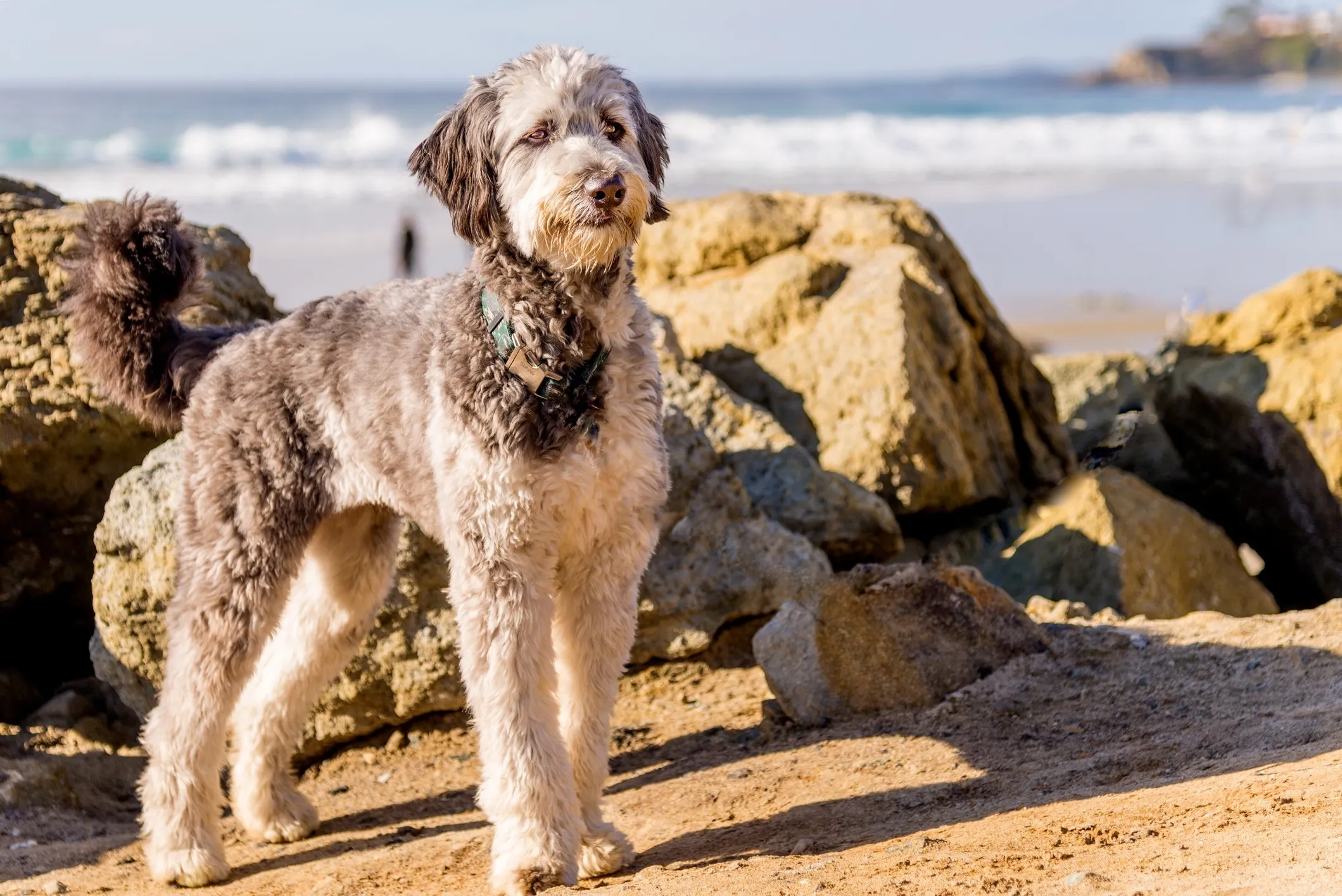 Standard Aussiedoodle dog standing on a beach
Standard Aussiedoodle dog standing on a beach
An Aussiedoodle is a cross between an Australian Shepherd and a Standard or Miniature Poodle. This hybrid often results in a low-shedding coat, inherited from the Poodle side. However, their coats can be quite dense and wavy/curly, requiring regular brushing to prevent tangles and mats, and professional grooming every few months. Aussiedoodles are known for being very smart and energetic, thanks to both parent breeds. They need plenty of exercise and mental stimulation to prevent boredom and destructive behaviors.
26. Whoodle
 Tan Whoodle puppy dragging a washcloth
Tan Whoodle puppy dragging a washcloth
When a Soft-Coated Wheaten Terrier is crossed with a Poodle, the result is a Whoodle – a friendly dog that sheds very little. These dogs inherit their intelligence and affectionate nature from both parent breeds. Their soft, wavy to curly coat requires regular brushing to keep it free of mats and occasional trimming. While their low-shedding nature is appealing, their grooming needs are consistent.
27. Bernedoodle
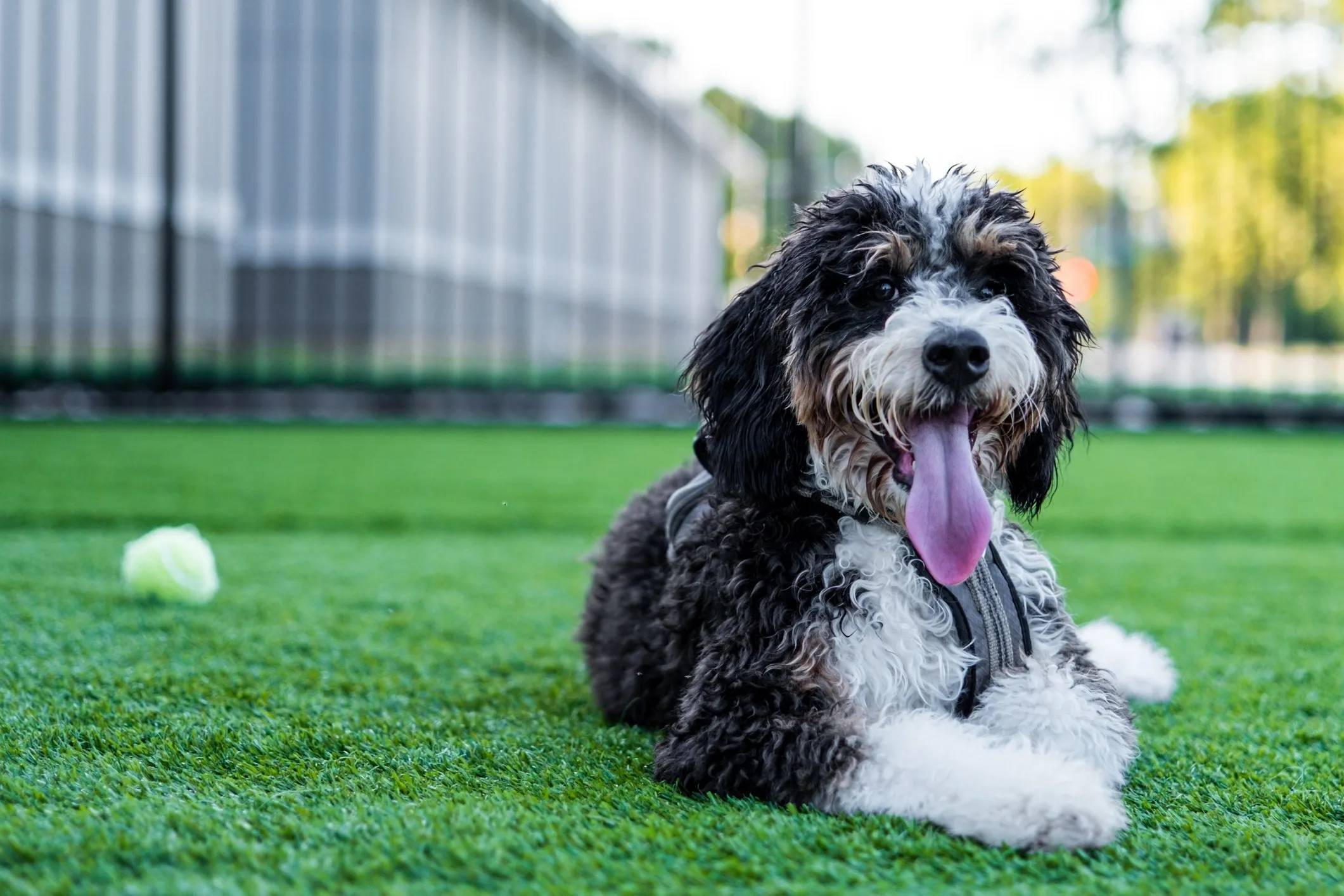 Large Bernedoodle dog lying in grass with his tongue out
Large Bernedoodle dog lying in grass with his tongue out
Bernedoodles are a crossbreed between Bernese Mountain Dogs and Poodles. Their friendly, affectionate nature and gentle demeanor make these large low-shedding dogs a popular choice for families. Their coat type can vary, from wavy to curly, and generally sheds minimally. However, to prevent matting and keep their coat healthy, they require regular brushing and professional grooming every 6-8 weeks. They are active dogs and need plenty of exercise.
28. Shorkie
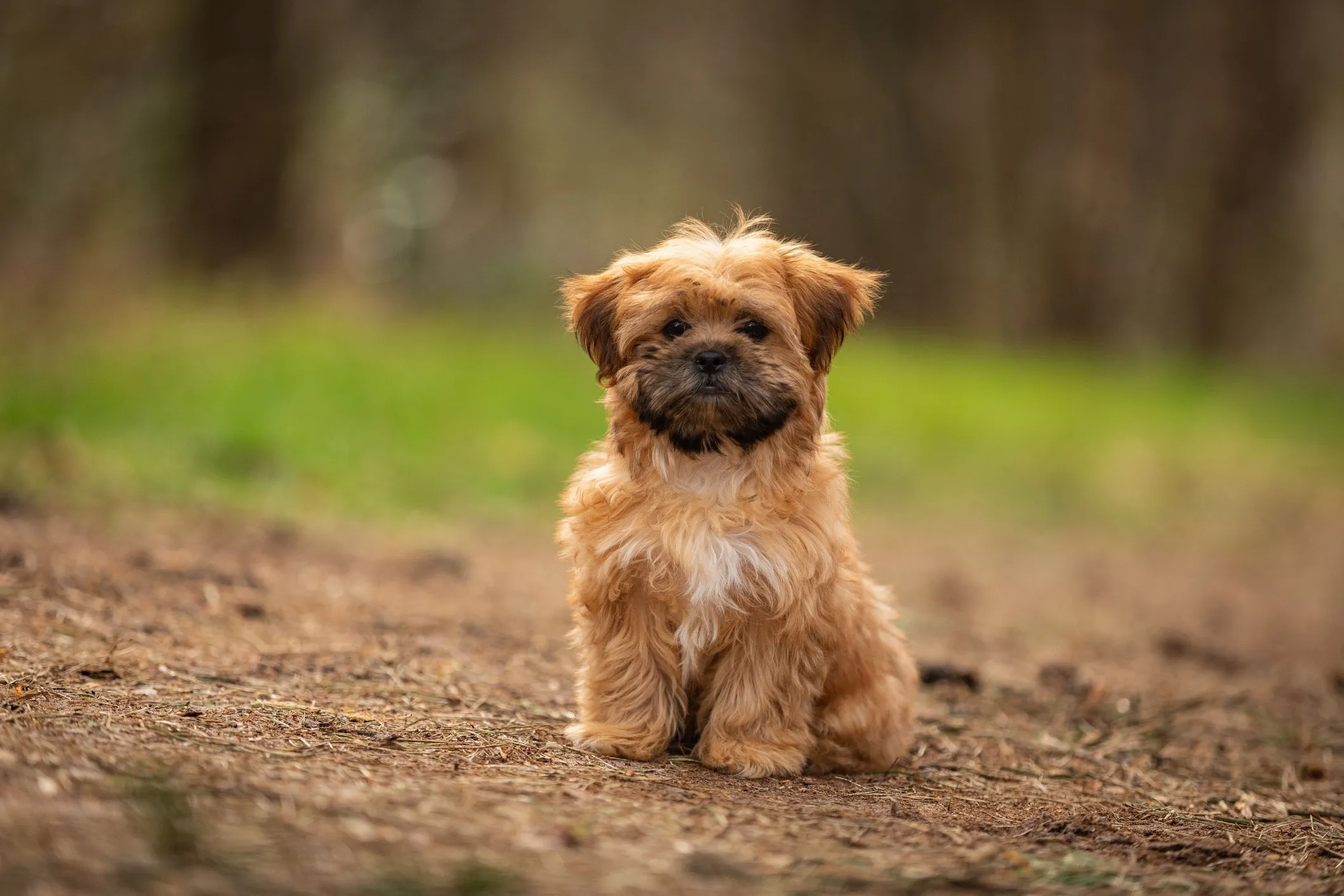 Tan and black Shih Tzu and Yorkie mix sitting on a hiking trail
Tan and black Shih Tzu and Yorkie mix sitting on a hiking trail
The Shorkie is a mixed breed created from a Shih Tzu and a Yorkshire Terrier, both low-shedding breeds. They are small, playful, and friendly, often combining the best traits of both parents. Their long, silky hair (if grown out) or soft, wavy coat requires daily brushing to prevent tangles. Many owners opt for a shorter haircut to make grooming more manageable. So, while they don’t shed, they demand a regular grooming routine. You might consider one of these white cute dog breeds in india price if you are looking for a small, charming companion.
29. Shih-Poo
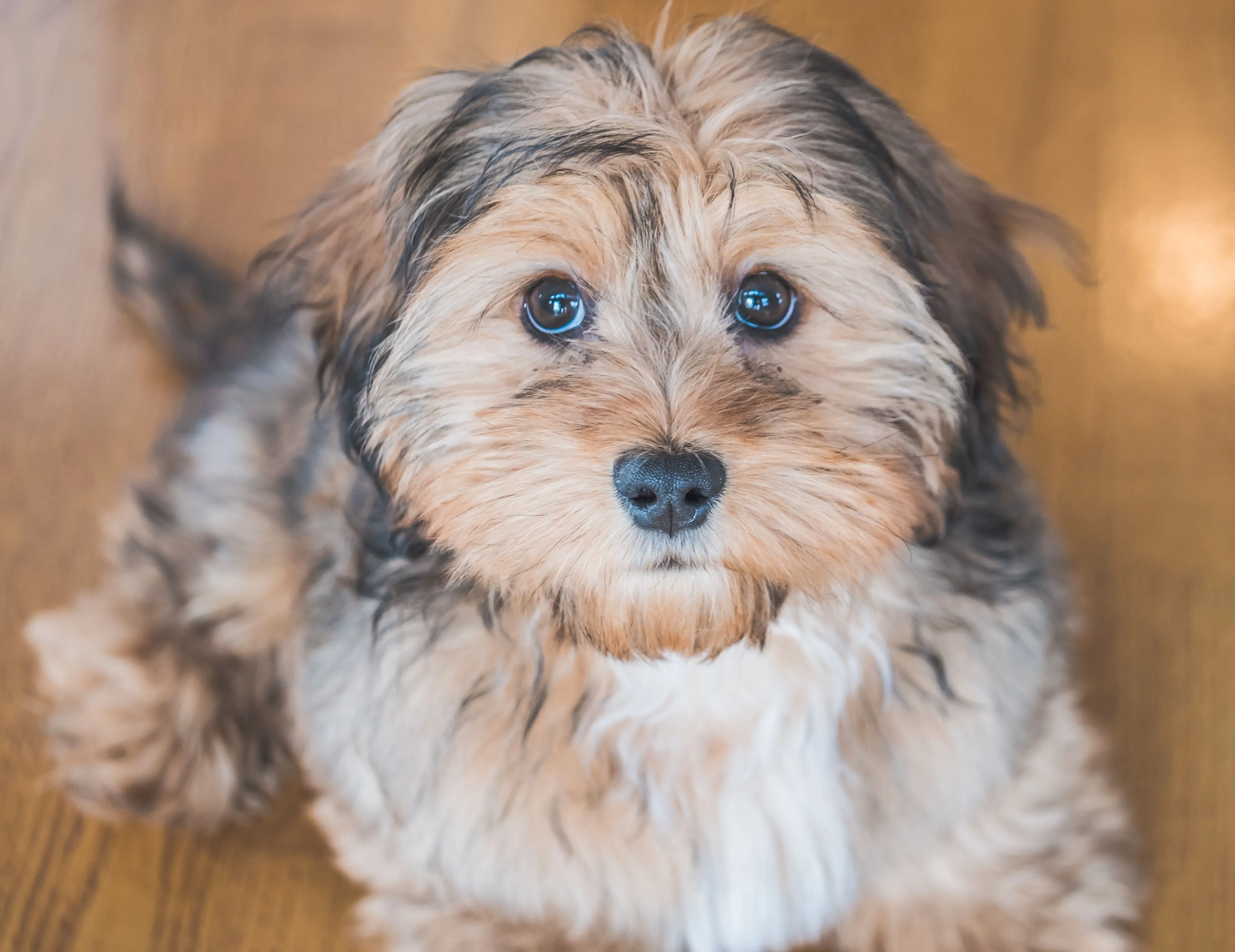 Tan and black Shih-Poo dog close-up
Tan and black Shih-Poo dog close-up
The Shih-Poo mixed breed is a cross between a Shih Tzu and a Poodle (most commonly the Toy Poodle). This small pup inherits a low-shedding coat that can be wavy or curly. To keep it healthy and mat-free, they require regular brushing and occasional professional grooming or trimming. Shih-Poos can thrive in almost any living situation, provided they receive about 30 minutes of daily exercise and consistent brushing sessions.
30. Malshi
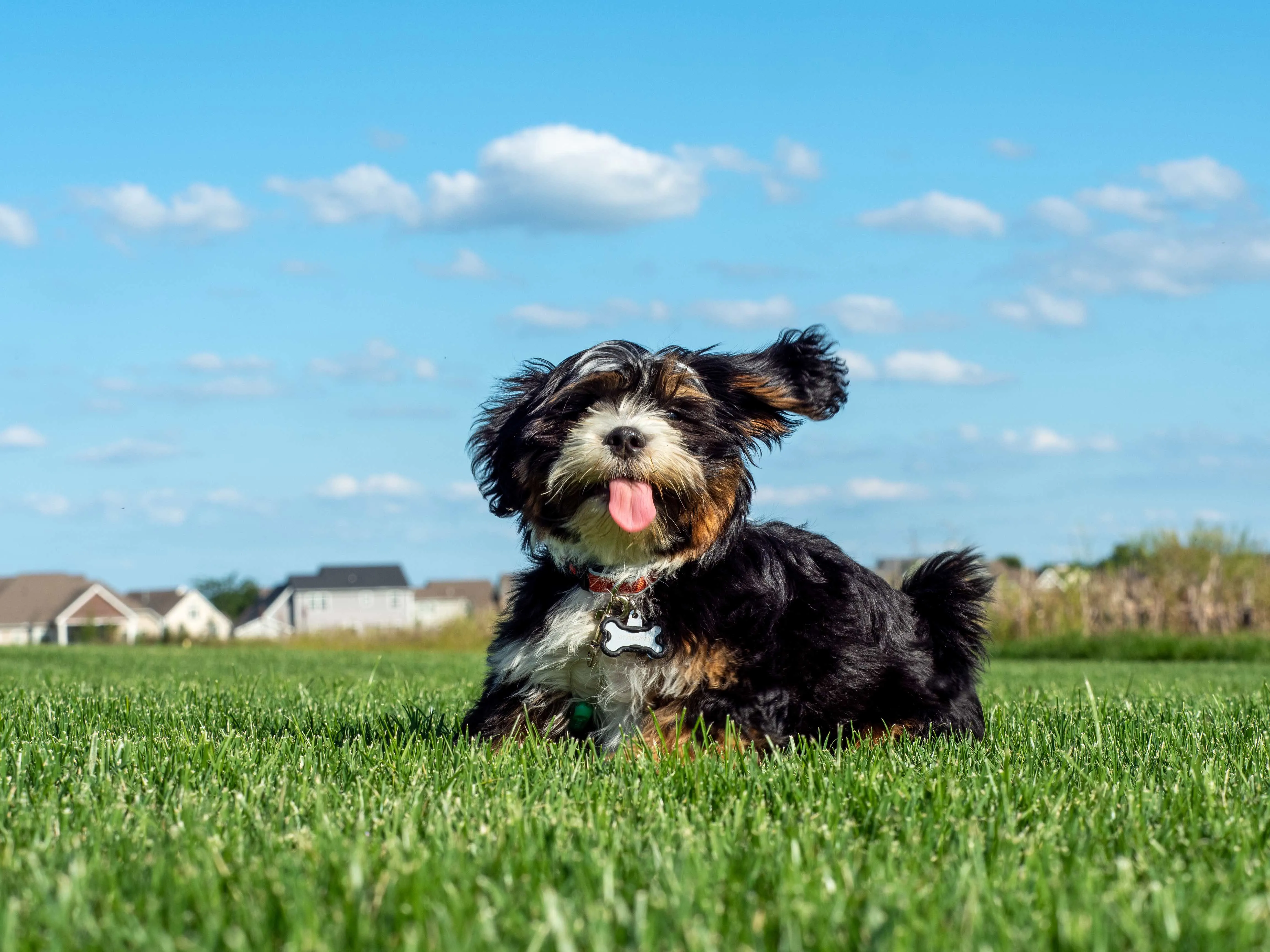 Tricolor Malshi dog in green grass
Tricolor Malshi dog in green grass
As a cross between the Maltese and Shih Tzu, the Malshi is a happy, small, low-shedding dog. They thrive on close companionship and are known for their affectionate nature. Their soft, flowing coat requires daily brushing to prevent mats, and many owners opt for a short “puppy cut” to simplify care. While they shed very little, their grooming needs are continuous.
Living with a Low-Shedding, Minimal Grooming Dog
Choosing a dog that sheds minimally and requires manageable grooming can simplify pet ownership, but it doesn’t eliminate the need for routine care. Even the most “low-maintenance” breeds still depend on their owners for basic health and hygiene.
Embrace Regular, Simple Grooming
For breeds with minimal grooming needs (hairless or short-coated), skin care is paramount. This may involve:
- Moisturizing: Applying a pet-safe moisturizer to prevent dry skin.
- Sun Protection: Using dog-specific sunscreen if your hairless dog will be exposed to prolonged sun.
- Occasional Baths: To keep their skin clean.
For low-shedding breeds with coats that do grow (curly, wiry, or silky), even if they don’t need professional trims, a regular at-home grooming routine is crucial. This includes:
- Consistent Brushing: Even a few times a week with the right brush can prevent tangles and remove any loose hair that might get trapped in the coat. This is far less demanding than grooming a heavy-shedding breed.
- Bathing: Bathe your dog every four to six weeks, or as needed, using a gentle dog shampoo. For those sensitive to dander, using a specialized dander-reducing shampoo can further minimize potential allergens.
- Professional Check-ups: Even if you manage grooming at home, occasional visits to a professional groomer can help identify any skin issues or matting you might miss.
Maintain a Clean Home Environment
Minimizing allergens and dog hair in your home extends beyond just grooming your dog. A clean living space is vital for a truly low-maintenance experience:
- Regular Cleaning: Vacuum, dust, and wash your bedding frequently. Pay special attention to areas where your dog spends most of its time.
- Air Purification: Using air purifiers with HEPA filters can help reduce airborne dander and other allergens, contributing to a cleaner environment.
- Ventilation: Keep your home well-ventilated to circulate fresh air.
Prioritize Overall Health and Well-being
Beyond coat care, remember that every dog, regardless of breed, needs comprehensive care for a happy and healthy life:
- Dental Care: Regular teeth brushing and professional dental cleanings are essential to prevent dental disease.
- Nail Trims: Keep nails trimmed short to prevent discomfort and potential paw problems.
- Ear Cleaning: Regularly check and clean your dog’s ears to prevent infections, especially for breeds with floppy ears.
- Veterinary Care: Routine check-ups with your veterinarian are non-negotiable for monitoring your dog’s overall health and addressing any concerns promptly.
Consult Your Doctor
If you or a family member has allergies, managing these symptoms is crucial. Bringing home a low-shedding dog can certainly help, but it’s wise to consult with your healthcare provider. They can offer advice on managing allergies, including medication, nasal sprays, or injections, and help you create a comprehensive plan to minimize allergic reactions while enjoying your new companion.
Conclusion
Choosing a dog that doesn’t shed much and requires minimal grooming can significantly enhance the pet ownership experience, particularly for those with allergies or busy lifestyles. While “no grooming” is a challenging ideal, many breeds offer a fantastic balance of very low shedding and manageable at-home coat care. From the unique hairless varieties to some short-coated breeds and even certain curly-coated dogs whose grooming is focused on maintenance rather than managing shedding, there’s a wide range of companions available.
Remember, every dog is an individual, and their specific needs may vary. The key is to understand the commitment required for each breed and ensure it aligns with your lifestyle and expectations. By carefully researching and choosing a breed that suits your needs, you can enjoy the boundless joy and companionship that a dog brings, with less worry about fur and extensive grooming routines.
References
- National Institute of Environmental Health Sciences. (n.d.). Pet Allergens. Retrieved from https://www.niehs.nih.gov/health/topics/agents/allergens/pets/index.cfm
- PetMD. (n.d.). Dog Breeds. Retrieved from https://www.petmd.com/dog/breeds (Accessed for various breed information, e.g., Poodle, Shih Tzu, Schnauzer, etc.)
- Chewy. (n.d.). Dog Grooming Supplies. Retrieved from https://www.chewy.com/b/brushes-combs-356 (General reference for grooming tools)
- The New York Times. (2019, September 25). Labradoodle Creator Regrets the Breed. Retrieved from https://www.nytimes.com/2019/09/25/us/labradoodle-creator-regret.html
- Affenpinscher Club of America. (n.d.). Grooming Your Affenpinscher. Retrieved from https://www.affenpinscher.org/images/pdfs/grooming_your_Affen.pdf
- Barbet Club of America. (n.d.). About the Barbet. Retrieved from https://www.barbetclubofamerica.com/barbet
